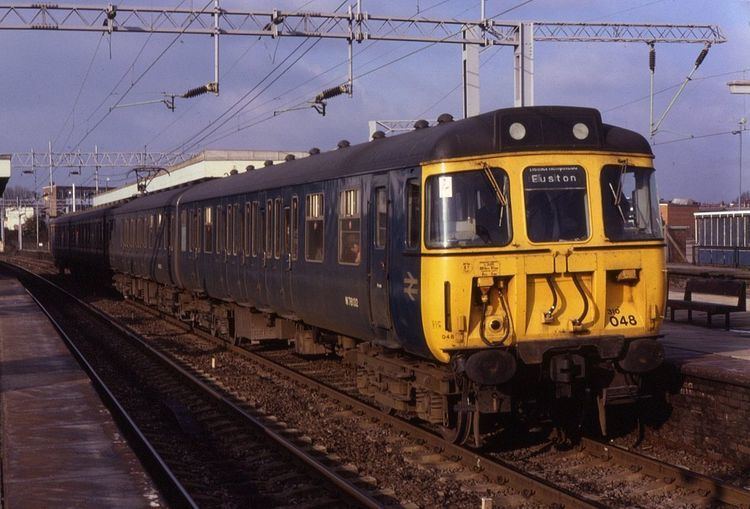In service 1963 - 2002 Refurbishment 1985 | Constructed 1965-1967 Number built 50 | |
 | ||
Manufacturer British Rail C&W Works Derby Order no. 30745 (BDTSOL)30746 (MBSO)30747 (TSO)30748 (DTCOL) | ||
The British Rail (BR) Class 310 is a slam-door, alternating current (AC) electric multiple unit (EMU) introduced in 1963 as part of the West Coast Main Line electrification project. They were initially classified as Class AM10 units before the introduction of the TOPS classification system. Constructed at BR's Derby Carriage and Wagon Works. They consisted of four carriages - a second class driving trailer, a second class trailer, a second class motor car (with guard's/luggage compartment above which the Stone Faiveley AMBR pantograph was mounted) and a composite (1st and 2nd class) driving trailer. The maximum speed was 75 miles per hour. A glass partition behind the driver's cab enabled passengers in the leading and rear coaches to have an excellent view of the line ahead or behind.
Contents
They introduced some new features; the first standard multiple units with disc brakes (emergency stop from top speed in 33 seconds over 800 yd (730 m)); the first naturally air-cooled rectifiers (silicon diodes on cups of beryllium oxide), inductors and transformers. Noise was reduced by sprayed asbestos on the floor, body and roof.
Original livery was overall Rail Blue, later amended to the familiar blue and grey colour scheme.
Initially they were primarily used on local services from London Euston to Bletchley, Milton Keynes, Northampton and Birmingham, and within the West Midlands. They were also the first EMUs to be based on the British Rail Mark 2 bodyshell, which featured semi-integral construction.
During the mid-1980s they underwent their heavy C1 refurbishment at Wolverton which included new flat windscreens, a corridor connection between the Motor Vehicle (MBS) and trailer (TSO), and a PA system among other modifications.
The Class 310 has a nearly identical body shell to that of the Class 312, there are some minor detail differences in the equipment locations and the MBS has a separate guards van and storage are whereas on the 312 it is combined. The braking system is slightly different with ventilated brake discs on the axles of the B4 non-powered bogies attached to the axles whereas on the Class 312 they are mounted on the wheel discs (this permits easy replacement in the case of defects). As are the motor bogies axles on the Class 310. When first arriving on the LT&S the Class 310 were modified with an additional plug being inserted in the dummy cylinder of each vehicle and a different size "choke" fitted in the Electro-pneumatic (EP)valve to improve the braking performance to that required on a more intensive service. Also the cast BR double arrows were removed from the cab sides on arrival, or soon after at East Ham Depot. The Class 310 stock also were used for a short while on the newly electrified route to Cambridge prior to replacement with more modern stock.
The motors differed from the class 312 in that the gear ratio is lower which accounts for the maximum speed of 75mph compared to 90mph on the Class 312. The B4 bogies on the Class 310 are fitted with friction primary dampers whereas on the 312 they are hydraulic.
The main fleet of Class 310/0 units was replaced on the Euston commuter routes with Class 317/1 units which began to enter service on the route in late 1987, however the Class 317 units were then superseded by the new build of Class 321/4 within about 2 years.
All Class 310 units that survived into the 21st century were withdrawn between 2001 and 2002.
Sub-classes
Accidents and incidents
Privatisation
All 310/0 units came under the control of LTS Rail (now c2c) which operated them on the London, Tilbury and Southend Railway. They were replaced by Class 357 units from 1999 to 2002.
The thirteen 310/1 units came under the control of Central Trains. All were withdrawn by 2002 and replaced by a mixture of Class 170 and Class 323 units.
Departmental usage
In 2002, vehicles from two Class 310/1 units, numbers 310109 and 310113, were used to create a single four-car departmental unit, 960201 which could operate on either alternating current (AC) or direct current (DC) lines for test purposes. The set consisted of two driving cars, a Class 310 power car with Hitachi equipment and either a standard Class 310 25 kV power car or a modified 650 V third rail vehicle from a Class 423 (4-VEP) unit. One of these two vehicles was included in the formation depending upon where the unit was operating (on 25 kV overhead lines or third rail). To facilitate third rail running, shoegear was fitted to each driving car. The unit was known as the 'Hitachi Verification Train' or 'V Train' and was used by Hitachi to test and prove its traction equipment in the UK. The subsequent order for the Class 395 Javelin trains which now run on the High Speed 1 line benefitted from this exercise. The V train was scrapped at MoD Pig's Bay in Shoeburyness in 2007. Details and more pictures of the V train on AC, DC and the High Speed 1 lines can be found at Train Testing - Hitachi's V train.
Preservation
While there were efforts online to acquire a single unit, none of the Class 310 units was preserved.
